By Larry Weishuhn
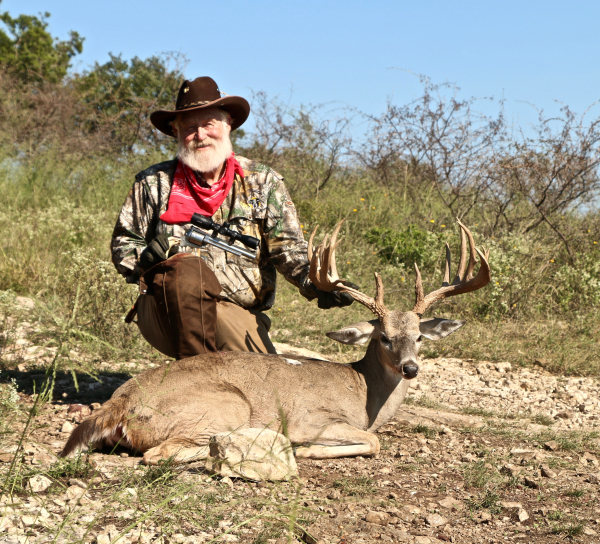
"Are you here to play cowboy or hunt?" Snicker, snicker, followed by, "Pray, tell what do you intend to do with that play toy?" Laughing now, said the grizzled guide when I pulled a .44 Mag revolver, topped with a Trijicon SRO sight out of my carry bag?
"I plan on taking the biggest buckshot on the hunt with this six-shooter," I replied, smiling.
I was the last of eight hunters to shoot, and I planned it that way. I made a big deal of loading six Hornady 240-grain XTP rounds into the revolver's cylinder. Then resting the handgun on a sandbag for a rest, I cocked the hammer, got solid, and fired at the 100-yard target. My first shot hit a half-inch high of the x-ring. I cocked the hammer, shot a second time. It printed a figure-eight with the first shot, cutting the bullseye, then I cocked the hammer in rapid succession and pulled the trigger a third time. All three bullet holes touched each other. The best three-shot group by those using long guns was three inches.
I watched the guide looking at my three-shot group through his spotting scope. Turning toward me with a raised eyebrow, "Maybe I misspoke a bit about you and your handgun." I smiled!
"The bullet goes where the barrel points when you pull the trigger!," I said while placing my revolver into my travel bag.
Last evening of the hunt, I shot a nice 20-inch wide, massive beamed 10-point, the biggest buck taken during that hunt. I love it when a plan comes together! "If you can do it, it's not bragging," as my dad used to say.
Ruger's Blackhawks (single-action), and Redhawks (double-action), as well as Taurus' Raging Hunter (double-action) chambered in .44 Magnum with ammo, especially ammo produced by Hornady, are indeed extraordinarily accurate and worthy of use for hunting big game species.
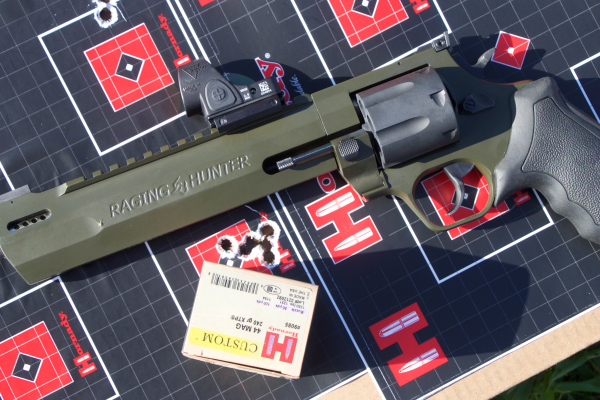
Suppose you are just getting started hunting with a handgun or simply thinking about doing so. In that case, I suggest starting with a single-action revolver because the hammer must be manually cocked before you pull the trigger. I usually recommend beginning down the handgun hunting road shooting a .22 rimfire revolver. Ammunition usually is readily available and not very costly compared to larger rounds. Starting with a .22 rimfire encourages a lot of shooting and practice to become familiar with a handgun and learn how to shoot it accurately while having fun.
My suggestion for a .22 rimfire revolver? There are plenty to choose from. The Ruger Wrangler is one of my personal favorites. It is reasonably priced, accurate, fun to shoot, and has "iron or open-sights," meaning a notch in the receiver and a bladed front sight. Such an open-sight handgun is a great way to learn how to shoot a handgun. Recoil and muzzle blast from a .22 rimfire is very tame.
I started seriously hunting with handguns back in the mid-1960s, using single-action .22 rimfires produced by Harrington & Richardson for small game like squirrels and rabbits and coyotes and bobcats. I moved from there to .357 Magnum and .44 Magnum single-action revolvers, and from there to the single-shot Thompson-Center Contender using a variety of calibers and rounds, all the way up to the .375 JDJ and .45/70 Government, then back to primarily revolvers in .44 Magnum and .454 Casull, big enough to take anything in North America. I occasionally run into hunters using semi-auto pistols chambered for 10mm or 11mm.
Me? I prefer revolvers over semi-autos, which is purely my personal preference. I love the looks and feel of single-action and some double-action revolvers. I have more control over a revolver than a semi-auto. Semi-autos are great for shooting numerous times quickly. Too, I prefer single-action revolvers chambered in larger caliber/rounds over double action because the single action's grip design allows the handgun when shot "to roll back into my hand," lessening felt recoil. Double actions have a "swell" on the back grip right at the web on the shooter's hand, which helps pull the trigger more smoothly when shooting double action. But unfortunately, the swell makes the felt recoil more substantial.

I have handgun hunted various big game species, including Alaskan brown bear and moose, elk, caribou, black bear, pronghorn, mule, and whitetail deer down to Javelina, a variety of South African plains game. I have used revolvers, mostly single-action but also some double actions; single-shots in a great variety of calibers and rounds; and some bolt actions. I own three semi-auto Model 1911s, but I personally really do not consider these to be hunting guns, although, during my early years, I used a Remington Model 1911, .45 ACP to hunt deer. It was the only handgun I had at the time.
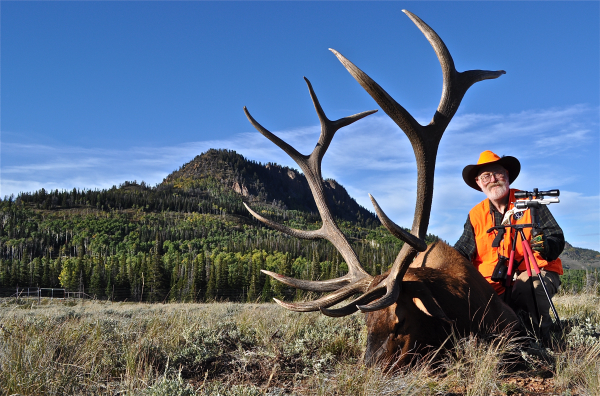
If you are just now getting into handgun hunting or simply thinking about it, I have no doubt you have questions. Let's address a few.
Let us start with what type of handgun you should consider for hunting. We have already briefly discussed single-action and double-action revolvers. There are also single-shot handguns to consider as well. One choice is the Thompson/Center (T/C) Contender, which is designed primarily for lower pressure rifle cartridges, like the .30-30 Winchester and traditional handgun rounds like the .44 Magnum. Another choice is the Thompson-Center Encore, designed to shoot classic, medium-pressure rounds like the .270 Winchester, .308 Winchester, and the .30-06 Springfield. Available too, if you can find them are some bolt action handguns, which unfortunately are no longer in production, like the Savage Striker, Remington XP-100, and a few others. These, too, were chambered in the medium pressure cartridges. Bolt action handguns are generally available on the used gun market or built by custom-maker gunsmiths.
What's right for you? That is a personal decision! Questions to consider are what big game species do you plan on hunting? What terrain will you be hunting in, and how far will you be shooting? Do you like the look of a revolver or a break-open single-shot or possibly bolt action?
For starters, let us say you primarily want to hunt whitetails in relatively thick cover, but someday may consider hunting a black bear or an elk with your handgun. Let us further say, you earlier bought a .22 rimfire revolver and shot it open/iron sights. You plinked with it quite a bit, can consistently hit a tin can at 20 yards, and have used it for hunting squirrels and rabbits successfully. Now you are ready for a bigger caliber handgun to hunt deer and possibly a bigger game. And you like the look and feel of a revolver. Once we get into hunting techniques with handguns later in this series, we will look at single-shot and bolt action handguns there.
Single-action or double-action? Personally, regardless of whether I shoot a single or double-action, I always cock the hammer between shots, even though I could pull the trigger for a quick second shot and beyond with a double-action. It's how I have always done things - cock the hammer before each shot. It probably goes back to my early years when I shot single-action revolvers exclusively.
I mentioned recoil briefly. I have learned over the years most shooters are more afraid of the loud "bang!" than the kick, although, with some handguns, it can be a bit. One of the many reasons it's important to wear hearing protection is hearing protectors inserted into your ears or in the form of earmuffs.
To me, double-action revolvers, caliber/round/load being the same, tend to have more felt recoil than do single-actions. Why? As explained earlier, the "swell" on the grip behind the hammer is there primarily to help squeeze off a quick second shot. This design tends to create more felt recoil, in my opinion.
Single-actions, such as most of the "Old West" style revolvers like those from Ruger, Freedom Arms, and a few others, have a smooth curved back grip. When you shoot a recoiling revolver, this grip design tends to roll into your hand. Wearing shooting or leather gloves seems to allow more roll than shooting "bare-hand."
There are essentially two grip styles with a single-action, the Standard and the Bisley. The latter's grip is curved downward at a more acute angle. Since my hands are relatively large, I am not a huge Bisley grip fan because when I shoot a Bisley grip revolver, I smash the knuckle of my middle finger. With the standard grip, there is more room between the back of the trigger guard and grip. Before you decide on a grip style, I suggest going to a gun store and holding each one to see which one fits your hand a bit better!
Handgun grips are made of several different materials, including wood, bone, antler, and various synthetics. I prefer wood or antler on single-actions. There are factory and after-market grips with double actions that will help absorb some of the recoil. The Taurus Raging Hunter double-actions I shoot have grips made of a softer, rubber-like material that truly helps reduce felt recoil.
Addressing recoil, quite a few years ago, Larry Kelly with Mag-na-port started porting revolvers and single-shot handguns to reduce significantly recoil, mainly those barrels produced by J.D. Jones and his SSK Industries. These include powerhouse rounds as the .375 JDJ, which is based on the .444 Marlin and necked to a .375. These rounds produced substantial recoil, to the point where they are referred to as "Hand Cannons," and rightfully so. But when the barrels are ported, they are fun to shoot. I long hunted with a .309 JDJ, ballistics like the .308 Winchester. Once ported, it was pleasant to shoot. For many years, I shot a .30-06 Springfield chambered in a T/C Encore. With a 15-inch ported barrel, its ballistics were a bit superior to a .308 Win. I shot it mostly in non-ported barrels and loved doing so. I used my .30-06 to take several moose and lesser-sized big game species.
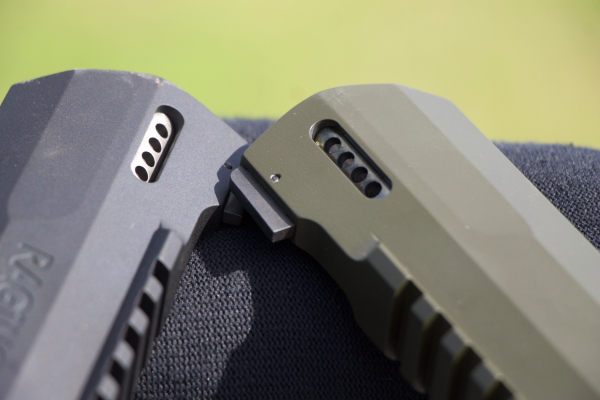
In shooting .44 Magnum and up, like the .454 Casull or .460 S&W Magnum, there can be a bit of recoil, depending upon the loads shot, barrel length, gun design, and other factors. For years I have hunted with a single-action Ruger Super Blackhawk Hunter chambered in .44 Magnum; I loved that gun, and I still do. I have recently been shooting and hunting with and loving Taurus's Raging Hunter, which has a fabulous porting system that dramatically reduces felt recoil in the three-round aforementioned. Although I will admit, the .460 S&W Magnum is a handful! I prefer shooting my Taurus Raging Hunter in .44 Magnum and .454 Casull. If you are a bit recoil sensitive, begin hunting serious big game with the .44 Mag rather than the .454 Casull. However, with the latter, you can also shoot a .45 Long Colt, making it fun to shoot, especially with commercially available ammo.
We have gravitated toward a choice of caliber/rounds. When addressing revolver rounds in hunting, I think in terms of .44 Magnum, .454 Casull, .460 S&W, and .480 Ruger. Those presented, I will tell you the .41 Magnum is an excellent round, but it has never achieved the popularity of the .44 Mag. That is partly due to Elmer Keith essentially developing the .44 Remington Magnum and Clint Eastwood years ago proclaiming it the world's most powerful handgun (which it is not) in the numerous "Dirty Harry" movies.
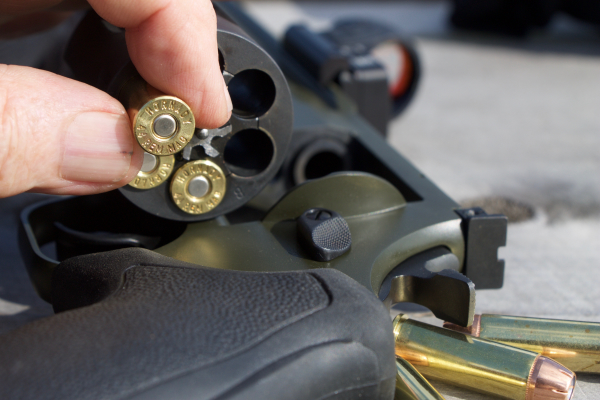
Some hunters have taken everything from Cape buffalo to rabbits with a .44 Magnum handgun, using proper bullets and knowing animal anatomy. Indeed, it should be a favorite, and in my opinion, the top of the list, when it comes to a caliber to use on deer to bear-sized animals. I have taken many deer with a .44 Magnum, several black bears, a few elk, and several animals in between.
I like the .454 Casull as well, and I will remind you once again that you can also shoot a .45 Long Colt in a .454 Casull, which has considerably less recoil. Most .45 Colt (this as opposed to the .45 ACP) ammo is loaded down considerably and not designed for hunting because the .45 Colt handguns of years ago were not designed for the pressure created by loads ideal for hunting. The .45 Colt can be an excellent handgun hunting round if you hand load! I have a couple of .45 Colt (again often referred to as a .45 Long Colt, instead of the round shot in .45 ACP, semi-autos like the old Model 1911s) revolvers. I love hunting with them, but with hand loads designed for hunting.
I have long been a fan of the .454 Casull and used it to shoot my first Alaskan Brown Bear years ago, a Freedom Arms revolver. The round killed the bear as quickly as any large magnum rifle round!
With the .44 Magnum I feel comfortable shooting a deer out to 100 yards. I shoot 240-grain Hornady XTP commercial loads exclusively in my .44 Magnums. I know there is other ammo, but I use it for a good reason. This load has never let me down in accuracy and down-range performance. With my.454 Casull Taurus Raging Hunter revolver, as with others I use, I feel comfortable shooting at deer out to about 125 when I'm shooting Hornady's 250-grain XTP ammo - and shooting from a solid rest.
I am not going to discuss hunting with rounds such as the .460 S&W Mag, .480 Ruger, .475 Linebaugh, or the .500 S&W Magnum. Why? These rounds produce substantial recoil, to the point most people do not shoot them accurately because they tend to develop a flinch due to their muzzle blast and kick!
I have also not addressed caliber/rounds less than .40. Some regularly hunt with a .357 Mag. In my opinion, based on years of hunting and being around some extremely adept and successful handgun hunters, the .357 Mag is an "expert's handgun round." True, it produces mild recoil. True, it shoots exceptionally accurately. But it is minimally (in my opinion) capable of killing a deer. It is an expert's round, meaning it is meant for hunters who can consistently place the bullet in the deer's vitals with precision while avoiding major bones. To me, the .357 Magnum lacks the needed down-range energy to, beyond close range, cleanly and quickly kill a deer. I know those who strongly disagree and have taken numerous deer with a .357 Magnum. More power to them. But, to me, it is not a cartridge a beginning handgun hunter should consider when looking for a deer gun.
Over the next few weeks, we will be looking at other handgun styles, sights, ammo, taking a solid rest, handgun hunting techniques, and telling a few handgun hunting stories!